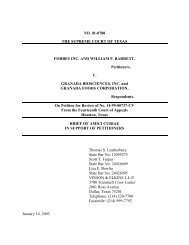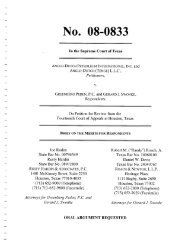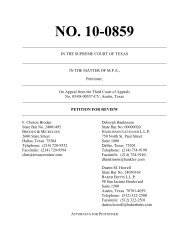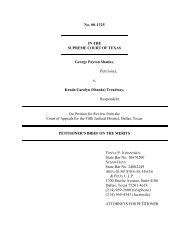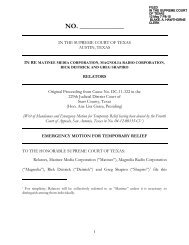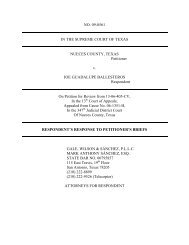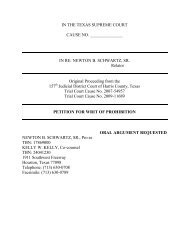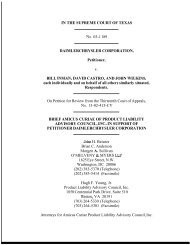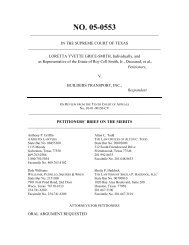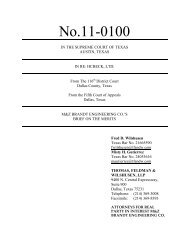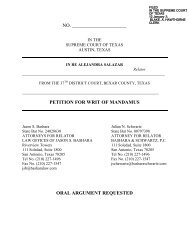Petition for Writ of Mandamus - Filed - Supreme Court of Texas
Petition for Writ of Mandamus - Filed - Supreme Court of Texas
Petition for Writ of Mandamus - Filed - Supreme Court of Texas
You also want an ePaper? Increase the reach of your titles
YUMPU automatically turns print PDFs into web optimized ePapers that Google loves.
Report (Form 05-163) annually to affirm that the entity<br />
qualifies as a passive entity. A passive entity is not required<br />
to file an Ownership In<strong>for</strong>mation Report (Form 05-167).<br />
A partnership or trust that qualifies as a passive entity <strong>for</strong><br />
the period upon which the franchise tax report is based,<br />
and is not registered and is not required to be registered<br />
with the SOS or Comptroller's <strong>of</strong>fice, will not be required to<br />
register with or file a franchise tax report with the<br />
Comptroller's <strong>of</strong>fice.<br />
A passive entity that is not registered with the Comptroller's<br />
<strong>of</strong>fice and that no longer qualifies as a passive entity must<br />
file a Nexus Questionnaire (Form AP-114) or a Business<br />
Questionnaire (Form AP-224) to register with the<br />
Comptroller's <strong>of</strong>fice and begin filing franchise tax reports.<br />
Disregarded Entities<br />
An entity's treatment <strong>for</strong> federal income tax purposes does<br />
not determine its responsibility <strong>for</strong> <strong>Texas</strong> franchise tax.<br />
There<strong>for</strong>e, partnerships, LLCs and other entities that are<br />
disregarded <strong>for</strong> federal income tax purposes, are considered<br />
separate legal entities <strong>for</strong> franchise tax reporting purposes.<br />
The separate entity is responsible <strong>for</strong> filing its own franchise<br />
tax report unless it is a member <strong>of</strong> a combined group. If the<br />
entity is a member <strong>of</strong> a combined group, the reporting entity<br />
<strong>for</strong> the group may elect to treat the entity as disregarded<br />
and will not unwind its operations from its "parent" entity. In<br />
this instance, it will be presumed that both the "parent" entity<br />
and disregarded entity have nexus in <strong>Texas</strong> <strong>for</strong><br />
apportionment purposes only. Whether or not the entity is<br />
disregarded <strong>for</strong> franchise tax, it must be listed separately<br />
on the affiliate schedule. Additionally, if the disregarded entity<br />
is organized in <strong>Texas</strong> or has physical presence in <strong>Texas</strong>, it<br />
will be required to file the appropriate in<strong>for</strong>mation report<br />
(Form 05-102 or 05-167).<br />
Margin<br />
Unless a taxable entity qualifies and chooses to file using<br />
the EZ computation, the tax base is the taxable entity's<br />
margin and is computed in one <strong>of</strong> the following ways:<br />
• Total Revenue times 70%<br />
• Total Revenue minus Cost <strong>of</strong> Goods Sold (COGS)<br />
• Total Revenue minus Compensation<br />
A taxable entity must make an annual election to deduct<br />
COGS or compensation by the due date <strong>of</strong> the franchise<br />
tax report, the extended due date or the date the report is<br />
filed, whichever is latest. The election to use COGS or<br />
compensation is made by filing the franchise tax report using<br />
one method or the other. This is an annual election and is<br />
effective <strong>for</strong> the entire period upon which the tax is based.<br />
After the due date or the extended due date <strong>of</strong> the report, a<br />
taxable entity may not amend its report to change its election<br />
to COGS or compensation. However, a taxable entity may<br />
amend its report to change its method <strong>of</strong> computing margin<br />
from COGS or compensation to 70% <strong>of</strong> total revenue or, if<br />
eligible, the EZ computation.<br />
Note: Not all entities will qualify to use COGS to compute margin.<br />
See instructions <strong>for</strong> Item 11. Cost <strong>of</strong> goods sold (COGS)<br />
on page 15 <strong>for</strong> more in<strong>for</strong>mation .<br />
Tax Rates<br />
The franchise tax rates are:<br />
• 1.0% (0.01) <strong>for</strong> most entities<br />
• 0.5% (0.005) <strong>for</strong> qualifying wholesalers and retailers<br />
• 0.575% (0.00575) <strong>for</strong> those entities with $10 million or less<br />
in annualized total revenue using the EZ computation<br />
Qualifying retailers and wholesalers are those entities that<br />
fall under Divisions F or G <strong>of</strong> the 1987 Standard Industrial<br />
Classification manual (www.osha.gov/pls/imis/<br />
sicsearch.html) who are primarily engaged in retail and/or<br />
wholesale trade and apparel rental activities classified as<br />
Industry 5999 or 7299 <strong>of</strong> the manual.<br />
An entity is primarily engaged in retail and/or wholesale trade if:<br />
1) the total revenue from its activities in retail and wholesale<br />
trade is greater than the total revenue from its activities<br />
in trades other than the retail and wholesale trades;<br />
2) except <strong>for</strong> eating and drinking places as described in<br />
Major Group 58 <strong>of</strong> Division G, less than 50% <strong>of</strong> the total<br />
revenue from activities in retail and wholesale trade<br />
comes from the sale <strong>of</strong> products it produces or products<br />
produced by an entity that is part <strong>of</strong> an affiliated group to<br />
which the taxable entity also belongs; and<br />
3) the taxable entity does not provide retail or wholesale utilities,<br />
including telecommunications services, electricity or gas.<br />
Note: A product is not considered to be produced if modifications<br />
made to the acquired product do not increase its sales price<br />
by more than 10%.<br />
Annualized Total Revenue<br />
To determine an entity's eligibility <strong>for</strong> the $1,030,000 no tax<br />
due threshold and qualification <strong>for</strong> the EZ computation, an<br />
entity must annualize its total revenue if the period upon which<br />
the report is based is not equal to 12 months.<br />
Note: The amount <strong>of</strong> total revenue used in the tax calculations will<br />
NOT change as a result <strong>of</strong> annualizing revenue. Total revenue<br />
will equal the prescribed amounts <strong>for</strong> the period upon which<br />
the tax is based.<br />
To annualize total revenue, divide total revenue by the<br />
number <strong>of</strong> days in the period upon which the report is based,<br />
and multiply the result by 365.<br />
Examples:<br />
1) A taxable entity's 2012 franchise tax report is based on<br />
the period 09-15-2011 through 12-31-2011 (108 days), and<br />
its total revenue <strong>for</strong> the period is $400,000. The taxable<br />
entity's annualized total revenue is $1,351,852 ($400,000<br />
divided by 108 days multiplied by 365 days). Based on its<br />
annualized total revenue, the taxable entity would NOT<br />
qualify <strong>for</strong> the $1,030,000 no tax due threshold, but is<br />
eligible to file using the EZ computation. The entity will<br />
report $400,000 as total revenue <strong>for</strong> the period.<br />
2) A taxable entity's 2012 franchise tax report is based on<br />
the period 03-01-2010 through 12-31-2011 (671 days),<br />
3




